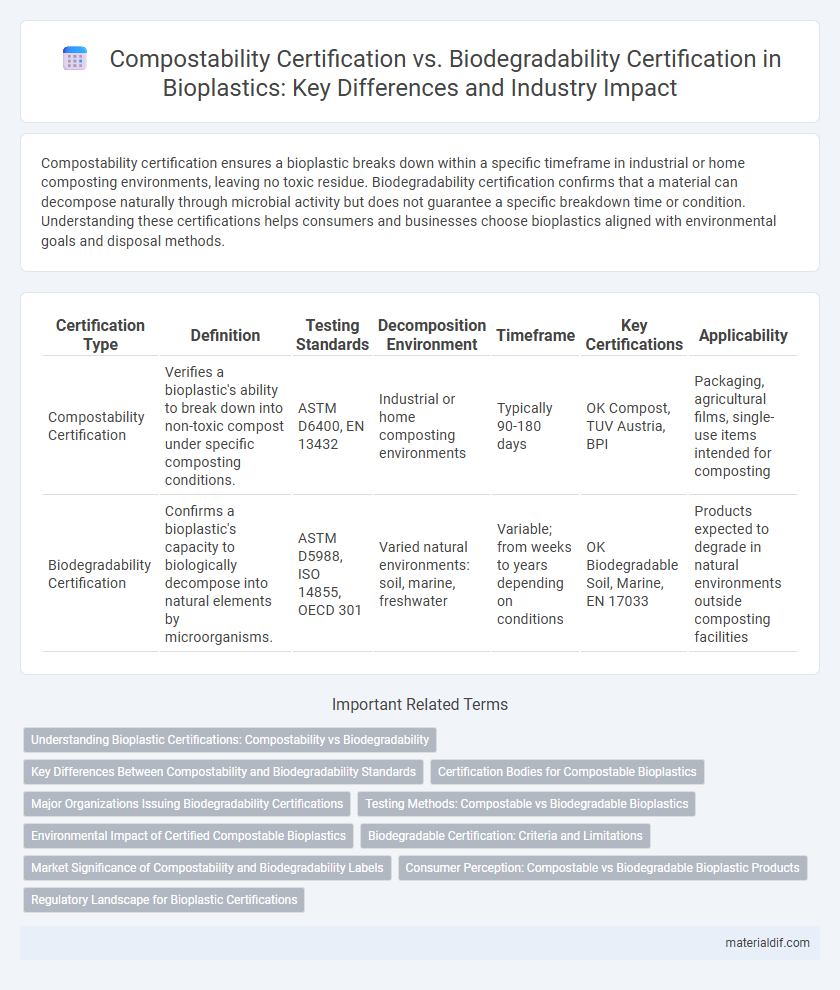Compostability certification ensures a bioplastic breaks down within a specific timeframe in industrial or home composting environments, leaving no toxic residue. Biodegradability certification confirms that a material can decompose naturally through microbial activity but does not guarantee a specific breakdown time or condition. Understanding these certifications helps consumers and businesses choose bioplastics aligned with environmental goals and disposal methods.
Table of Comparison
| Certification Type | Definition | Testing Standards | Decomposition Environment | Timeframe | Key Certifications | Applicability |
|---|---|---|---|---|---|---|
| Compostability Certification | Verifies a bioplastic's ability to break down into non-toxic compost under specific composting conditions. | ASTM D6400, EN 13432 | Industrial or home composting environments | Typically 90-180 days | OK Compost, TUV Austria, BPI | Packaging, agricultural films, single-use items intended for composting |
| Biodegradability Certification | Confirms a bioplastic's capacity to biologically decompose into natural elements by microorganisms. | ASTM D5988, ISO 14855, OECD 301 | Varied natural environments: soil, marine, freshwater | Variable; from weeks to years depending on conditions | OK Biodegradable Soil, Marine, EN 17033 | Products expected to degrade in natural environments outside composting facilities |
Understanding Bioplastic Certifications: Compostability vs Biodegradability
Compostability certification verifies that bioplastic products break down into non-toxic components within a specific timeframe under industrial composting conditions, ensuring they contribute to nutrient-rich compost. Biodegradability certification assesses the ability of bioplastics to decompose through microbial activity over variable environments but does not guarantee non-toxic residue or controlled timeframes. Understanding the distinction between these certifications helps manufacturers and consumers select appropriate bioplastics aligned with environmental goals and disposal infrastructure.
Key Differences Between Compostability and Biodegradability Standards
Compostability certification requires materials to break down into non-toxic components within a specific timeframe under controlled composting conditions, ensuring no harmful residues remain. Biodegradability certification assesses the ability of materials to decompose naturally through microbial activity but does not guarantee complete breakdown within set periods or environmental safety. Key differences lie in testing protocols, timeframes for degradation, and environmental impact requirements, with compostability standards being more stringent and application-specific.
Certification Bodies for Compostable Bioplastics
Certification bodies for compostable bioplastics, such as TUV Austria (OK Compost) and BPI (Biodegradable Products Institute), ensure materials meet standardized compostability criteria like ASTM D6400 and EN 13432. These certifications verify that bioplastics break down within municipal or industrial composting environments without leaving toxic residues. Unlike biodegradability certification, which measures material breakdown under various conditions, compostability certification specifically confirms compatibility with composting infrastructure and environmental safety.
Major Organizations Issuing Biodegradability Certifications
Major organizations issuing biodegradability certifications include ASTM International, TUV Austria, and the Biodegradable Products Institute (BPI). ASTM International provides standards such as ASTM D6400 for compostability and ASTM D5338 for aerobic biodegradation. TUV Austria offers certifications like OK Compost for industrial and home composting, while BPI verifies products meeting ASTM D6400 for compostable plastics, ensuring compliance with biodegradability and compostability criteria.
Testing Methods: Compostable vs Biodegradable Bioplastics
Compostability certification requires testing under controlled industrial composting conditions, measuring parameters like disintegration, biodegradation rate, and ecotoxicity to ensure the bioplastic breaks down into non-toxic residues within a specified timeframe. Biodegradability certification involves testing under broader environmental conditions such as soil, marine, or freshwater, assessing the material's ability to convert into natural elements like carbon dioxide, water, and biomass through microbial activity. Standards such as ASTM D6400 for compostability and ASTM D5988 for biodegradability define the specific testing protocols to evaluate the environmental impact and decomposition efficiency of bioplastics.
Environmental Impact of Certified Compostable Bioplastics
Certified compostable bioplastics break down into non-toxic, nutrient-rich compost within specific timeframes under defined conditions, significantly reducing landfill waste and methane emissions compared to traditional plastics. Biodegradability certification, while indicating material breakdown, does not guarantee complete composting or absence of microplastic residues, which can persist in the environment. Environmental impact assessments reveal that certified compostable bioplastics support circular economy initiatives by enabling organic waste integration and lowering overall carbon footprints through efficient end-of-life management.
Biodegradable Certification: Criteria and Limitations
Biodegradable certification requires that a bioplastic break down into natural elements within a specific timeframe under certain environmental conditions, typically focusing on soil or marine environments. Criteria often include the absence of toxic residues and complete mineralization, but limitations involve variability in degradation rates due to differing conditions and testing methods. Unlike compostability certification, which mandates biodegradation in industrial composting facilities within a strict timeframe, biodegradable certification does not guarantee disintegration in all waste management systems.
Market Significance of Compostability and Biodegradability Labels
Compostability certification ensures that bioplastics break down under specific composting conditions, meeting standards like ASTM D6400 or EN 13432, which is crucial for market acceptance in industries targeting organic waste management. Biodegradability certification indicates the material decomposes by natural biological processes but lacks the guarantee of leaving no harmful residues, making it less stringent yet valuable for broader environmental claims. The market favors compostability labels for products intended for industrial composting facilities, driving consumer trust and regulatory compliance, while biodegradability certifications appeal to wider applications where controlled composting infrastructure is absent.
Consumer Perception: Compostable vs Biodegradable Bioplastic Products
Consumers often perceive compostable bioplastic products as more environmentally responsible than biodegradable ones due to clear end-of-life benefits like soil enrichment through industrial composting. Compostability certification assures consumers that the product will break down under specific composting conditions without leaving harmful residues, enhancing trust in its eco-friendly claims. In contrast, biodegradable certification lacks standardized timelines and conditions, leading to confusion and skepticism about the actual environmental impact and disposal methods.
Regulatory Landscape for Bioplastic Certifications
Compostability certification ensures bioplastics break down under specific composting conditions within a defined timeframe, meeting standards like ASTM D6400 or EN 13432, which are critical for industrial composting compliance. Biodegradability certification verifies the material's ability to decompose naturally but does not guarantee disintegration within composting facilities, often based on standards such as ASTM D5338 or ISO 14855. Regulatory frameworks increasingly emphasize compostability certifications to align with waste management policies and promote environmental sustainability in bioplastic applications.
Compostability certification vs Biodegradability certification Infographic

 materialdif.com
materialdif.com